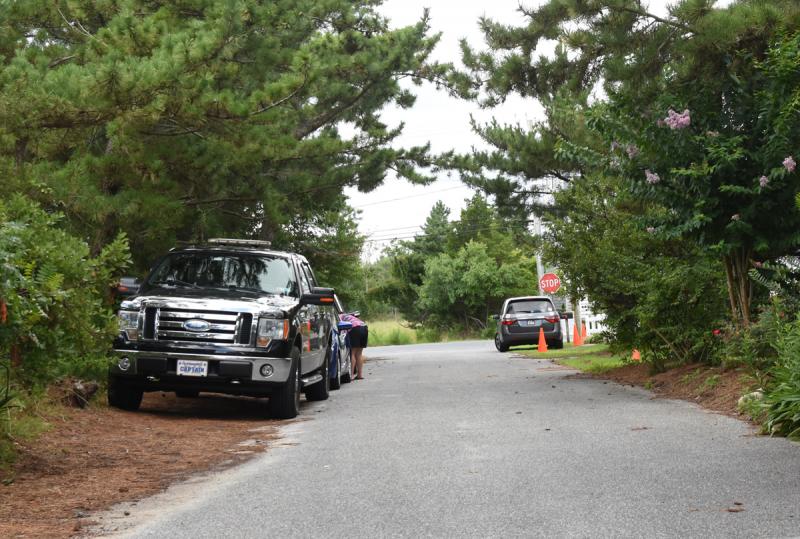A lot of opinions and ideas have been proposed to fix the parking issues on Lewes Beach, and the committee charged with offering recommendations to city council is narrowing down the list.
Deputy Mayor Fred Beaufait, committee chair, noted the problem is seasonal, only causing problems six to eight weekends a year.
“If it were a year-round problem, we would probably take pretty drastic steps,” Beaufait said at the committee’s Sept. 17 meeting. “But it’s a seasonal problem, and so I think we have to take appropriate steps recognizing that.”
With that in mind, the committee determined there is no immediate need for parking permits, a new parking lot at the beach or a jitney service.
Beaufait said a jitney would be too costly to the city. He said for it to operate efficiently, the city would have to purchase three or four buses to ensure pick-ups and drop-offs every 10 to 15 minutes.
“[Buses] are not cheap,” he said. “And they’re going to have to run from 8 a.m. to 6 p.m. We’re talking about a huge expense. I don’t think it would ever pay for itself. My feeling is a jitney service is kind of a last resort and something way in the future if we really just can’t manage.”
For the short term, the committee did not like the idea of adding a new parking lot at the main public beach. Along with potential environmental issues related to removing a dune, a parking lot would add several hundred more people to an already-crowded beach. With continued development just outside city limits, the committee agreed a parking lot could be a consideration down the road.
“What I hear from the lifeguards is that it’s pretty crowded and about at capacity,” Beaufait said. “We’d have to bring in more lifeguards and expand coverage. I don’t know that we want to jam more people in that small area.”
There are 237 spaces in the main public parking lot, with an additional 132 in the secondary public lot.
Councilman Dennis Reardon said he thinks an additional parking lot could be a possible solution.
“I know it has a lot of issues attached to it, like stormwater runoff and things of that nature,” he said. “I agree it’s not something we have to do at this moment, but I think it’s certainly a very viable consideration going forward.”
Pres Lee, Board of Public Works president and beach resident, disagreed. He was the lone vote against the committee’s motion to defer action on the issue until a later time.
“If you build it, it would fill up and you have the same problem,” he said, adding it would not solve any of the existing issues.
The committee had similar feelings about permit parking at the beach. Beaufait said permits lead to a closed community.
“I don’t think it’s an appropriate way to address our issues,” he said. “To me, it’s just not Lewes.”
With permits come a variety of administrative issues, he said, including added personnel to sell permits and patrol the area. Parking would also have to be delineated, he said.
“We only have six or seven weekends where we have a lot of parking over there,” Reardon said. “I don’t think there’s a need to consider parking permits at this time. If the situation escalates to the point where it’s that bad, we should consider it.”
One of the more challenging issues to tackle is encroachment by residents of the city’s right of way on the streets between Cedar Street and Bay Avenue. Over the years, residents have intentionally and unintentionally placed landscaping, mailboxes, rocks and other objects in the right of way. In many cases, the objects prevent people from parking on the public street. The committee agreed the first step is to identify the right of way. City Manager Ann Marie Townshend will get estimates from engineers to survey all streets from Savannah Road to Roosevelt Inlet. She is hoping to have the estimates in time for the committee’s next meeting at 10:30 a.m., Tuesday, Oct. 2.
“It seems to me that we need to be able to clearly identify where the property lines are rather than eyeballing it,” Beaufait said. “We need to know where we are.”
The next step would be to determine a course of action for obstructions on the city’s property. Reardon said that will be a significant challenge because some obstructions are intentional, while others have been there a long time, and some were approved through license with the city.
“We have to be very careful,” Reardon said. “We’re almost going to have to go street by street.”
Beaufait suggested one option could be to lay timbers on the property lines to clearly define areas to park. No matter what the committee and eventually city council decides, he said, he foresees some backlash from residents.
“It’s going to be a thorny issue, no question about that,” he said.
Reardon agreed the timber idea could be a possible solution.
“That would be a big help and it would still maintain the character of the beach,” he said. “I don’t particularly feel like I want to see curbing over there because that would change the whole character.”
Nick Roth is the news editor. He has been with the Cape Gazette since 2012, previously covering town beats in Milton and Lewes. In addition to serving on the editorial board and handling page layout, Nick is responsible for the weekly Delaware History in Photographs feature and enjoys writing stories about the Cape Region’s history. Prior to the Cape Gazette, Nick worked for the Delmarva Media Group, including the Delaware Wave, Delaware Coast Press and Salisbury Daily Times. He also contributed to The News Journal. Originally from Boyertown, Pa., Nick attended Shippensburg University in central Pennsylvania, graduating in 2007 with a bachelor’s degree in journalism. He’s won several MDDC awards during his career for both writing and photography. In his free time, he enjoys golfing, going to the beach with his family and cheering for Philadelphia sports teams.






















































